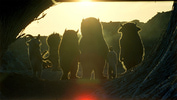The Hidden Adult Themes of “Where the Wild Things Are”

It’s an absolute fixture in children’s libraries worldwide and upon its publication in 1963 was awarded the Caldecott Medal, a distinguished award given to the year’s best picture book for children as decided by the Association for Library Service to Children. In the years since, it has inspired countless toys and children’s games. But after “Where the Wild Things Are” became a big-budget Hollywood adaptation, people finally began to ask if it’s really a children’s story.
The fact that “Where the Wild Things Are” is primarily made up of author Maurice Sendak’s illustrations certainly endears it to children but its themes of isolation, growth, and dreams has spoken to adults for years.
Three years ago, Hollywood press circulated rumors that the film had to be completely reshotafter Warner Bros and Jonze began clashing. The word was that Jonze had shot the film with adults primarily in mind and did not address a children’s audience enough. Whatever changes were made to the original version of the film, it’s still being reviewed in some cases as an adult adventure masquerading as a children’s story. Analyze the background of its author and illustrator, Sendak, and you may find this isn’t terribly surprising.
Already 35 years old when the book was published, Sendak was downright defiant in approaching questions about the film’s appropriateness for children. What’s more, in a documentary featured on HBO, Sendak claimed he didn’t “believe in childhood.” Sendak’s telling the New York Times in 2008 that he had never revealed his homosexuality to his parents and “all I wanted was to be straight so my parents could be happy” further accentuates some of the potentially-adult themes explored in “Where the Wild Things Are.” Same goes for some of the Holocaust references and sexuality in another of his picture books, “In the Night Kitchen.”
To be sure, “Where the Wild Things Are,” both the book and film, will continue to entertain countless children, as will the countless toys it inspired. But when it comes to the adult audience, they might share a more visceral, profound response to the story, and that may not be entirely unintended.
Editor’s note: This article originally appeared on Big Think in 2009.




